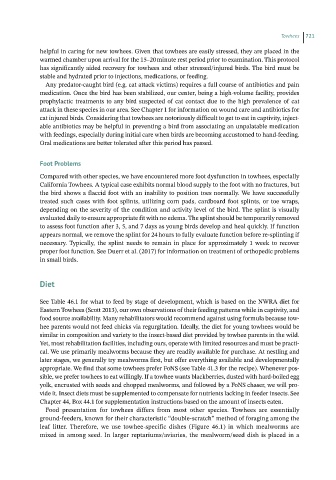Page 719 - Hand rearing birds second
P. 719
Towhees 721
helpful in caring for new towhees. Given that towhees are easily stressed, they are placed in the
warmed chamber upon arrival for the 15–20 minute rest period prior to examination. This protocol
has significantly aided recovery for towhees and other stressed/injured birds. The bird must be
stable and hydrated prior to injections, medications, or feeding.
Any predator-caught bird (e.g. cat attack victims) requires a full course of antibiotics and pain
medication. Once the bird has been stabilized, our center, being a high-volume facility, provides
prophylactic treatments to any bird suspected of cat contact due to the high prevalence of cat
attack in these species in our area. See Chapter 1 for information on wound care and antibiotics for
cat injured birds. Considering that towhees are notoriously difficult to get to eat in captivity, inject-
able antibiotics may be helpful in preventing a bird from associating an unpalatable medication
with feedings, especially during initial care when birds are becoming accustomed to hand-feeding.
Oral medications are better tolerated after this period has passed.
Foot Problems
Compared with other species, we have encountered more foot dysfunction in towhees, especially
California Towhees. A typical case exhibits normal blood supply to the foot with no fractures, but
the bird shows a flaccid foot with an inability to position toes normally. We have successfully
treated such cases with foot splints, utilizing corn pads, cardboard foot splints, or toe wraps,
depending on the severity of the condition and activity level of the bird. The splint is visually
evaluated daily to ensure appropriate fit with no edema. The splint should be temporarily removed
to assess foot function after 3, 5, and 7 days as young birds develop and heal quickly. If function
appears normal, we remove the splint for 24 hours to fully evaluate function before re‐splinting if
necessary. Typically, the splint needs to remain in place for approximately 1 week to recover
proper foot function. See Duerr et al. (2017) for information on treatment of orthopedic problems
in small birds.
Diet
See Table 46.1 for what to feed by stage of development, which is based on the NWRA diet for
Eastern Towhees (Scott 2013), our own observations of their feeding patterns while in captivity, and
food source availability. Many rehabilitators would recommend against using formula because tow-
hee parents would not feed chicks via regurgitation. Ideally, the diet for young towhees would be
similar in composition and variety to the insect‐based diet provided by towhee parents in the wild.
Yet, most rehabilitation facilities, including ours, operate with limited resources and must be practi-
cal. We use primarily mealworms because they are readily available for purchase. At nestling and
later stages, we generally try mealworms first, but offer everything available and developmentally
appropriate. We find that some towhees prefer FoNS (see Table 41.3 for the recipe). Whenever pos-
sible, we prefer towhees to eat willingly. If a towhee wants blackberries, dusted with hard‐boiled egg
yolk, encrusted with seeds and chopped mealworms, and followed by a FoNS chaser, we will pro-
vide it. Insect diets must be supplemented to compensate for nutrients lacking in feeder insects. See
Chapter 44, Box 44.1 for supplementation instructions based on the amount of insects eaten.
Food presentation for towhees differs from most other species. Towhees are essentially
ground‐feeders, known for their characteristic “double‐scratch” method of foraging among the
leaf litter. Therefore, we use towhee‐specific dishes (Figure 46.1) in which mealworms are
mixed in among seed. In larger reptariums/aviaries, the mealworm/seed dish is placed in a

